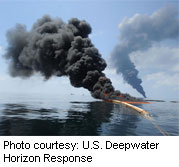
THURSDAY, June 3 (HealthDay News) — With the giant oil spill in the Gulf of Mexico now in its sixth week, reports of clean-up workers falling ill are on the rise.
“Within the past week, we’ve seen a number of workers hospitalized. That’s new,” said Dr. Gina Solomon, a senior scientist with the Natural Resources Defense Council.
More than a dozen workers have been treated at local medical centers for flu-like symptoms ranging from chest pain to dizziness, nausea and headaches, presumably due to exposure to different chemicals emanating from the slick, according to news reports.
The Unified Command in Louisiana — a coalition of government agencies that includes the U.S. Coast Guard, the Department of the Interior and the National Parks Service — last week called back to shore 125 boats helping with the clean-up after medical complaints from crew members.
“The reports that we’ve heard from hospitals and doctors have been [that the symptoms are due to] inhaled irritant exposure, but they’ve not gone so far as to say what exactly they think the responsible agent might be,” Solomon said. “The workers are widely blaming the dispersants.”
Dispersants are chemicals used for the oil clean-up. The solvent used after the massive 1989 Exxon Valdez oil spill off the Alaska coast, for example, was limonene, which can cause skin inflammation and asthma, said Robert Emery, vice president for safety, health, environment and risk management at the University of Texas Health Science Center at Houston.
“There’s no doubt that people are getting sick out there [in the Gulf of Mexico],” Emery said. “The key question is what is it that is causing them to get sick.”
Dr. Stuart Dobbs, chief quality and patient safety officer at The Methodist Hospital in Houston, said: “The more people that are involved, the more problems you’re going to have, particularly respiratory and dermatologic effects.”
“The hydrocarbons that compose the oil and the different components of the oil are all irritating to the skin and all are very aeromatically dispersed, so that means that the odors and the chemicals are present in air. As workers are exposed to it, they’re going to breathe in more and more. It goes along with the smell,” he added.
BP’s Deepwater Horizon exploded and sank in the Gulf of Mexico about 40 miles south of Louisiana on April 20, killing 11 workers and spewing an estimated 21 million to 45 million gallons of crude oil into the water.
BP and the U.S. Coast Guard have said dehydration, heat, food poisoning or other unrelated factors may have caused the workers’ symptoms. The Louisiana Department of Health and Hospitals is investigating, the Associated Press reported.
The U.S. Environmental Protection Agency reports that “air quality levels for ozone and particulates are normal on the Gulf coastline for this time of year.” But, the agency added, it has detected some “odor-causing pollutants associated with petroleum products along the coastline at low levels.” These chemicals could cause headache, nausea and throat irritation.
There have been few studies that have examined the long-term health risks of exposure to oil. Brief contact with small amounts of light crude oil and dispersants aren’t thought to be harmful, the AP reported. But, extended exposure to dispersants can cause central nervous system problems, or damage to the blood, the kidney, or the liver, and leave a metallic taste in the mouth, according to the U.S. Centers for Disease Control and Prevention.
The unprecedented size and duration of this spill makes it unsettling, Solomon said.
“It’s pretty much in every sense a historical spill,” Solomon said. “Previous spills have all happened over a relatively short period of time and then the clean-up effort has mostly been on what’s called weathered oil” — oil that’s been floating on the surface of water for some period of time.
“In this case, we still have fresh oil bubbling up from underwater, which is a completely different situation than has ever been seen before,” she said. “Approximately 40 percent of crude oil evaporates within several hours of reaching the surface of the water. It ends up airborne. It’s really a problem for people who are working out there, especially those closest to where oil is surfacing.”
Clean-up workers are being advised to follow federal guidelines that recommend that anyone involved wear protective equipment such as gloves, safety glasses and clothing, the AP said.
BP CEO Tony Hayward has said the symptoms that workers are reporting — dizziness, headaches, coughing — could be due to any number of causes, including diesel fumes, exhaustion and heat from wearing Tyvek safety suits.
More information
The U.S. Centers for Disease Control and Prevention has more on the oil spill.

